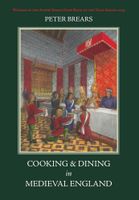Advertisement
The Saucery
By Peter Brears
Published 2008
Medieval sauces may be readily divided into two distinct types. The first to be considered here were cold, strongly flavoured and very long-lasting, rather like modern ketchups; the second were usually hot, well-flavoured, and freshly-made to accompany a particular dish. The first type might be made by a domestic cook, but was often the work of either a professional, town-based sauce-maker, such as John Romby of York, or of the saucery or ‘salsery’ division of a major household.1 Edward III’s saucery was staffed by a single sergeant, but by 1455 Henry VI’s had a sergeant, a clerk, a yeoman and a groom making sauces for the King, and four others making those served in the hall.2 The spices they needed were delivered every day from the spicery, whose clerk recorded their quantity, and reported them to the counting house. Much of their vinegar was produced from unserviceable wines remaining in the cellar, while their bread presumably came from the bakehouse or pantry.3 Since they were probably busiest at meal times, the saucery staff tended to eat in their own office, rather than in the hall.4

